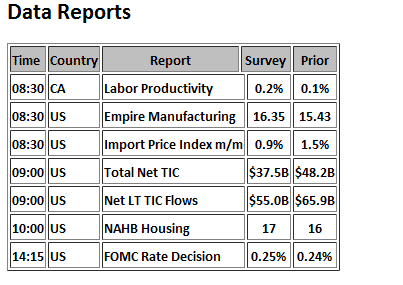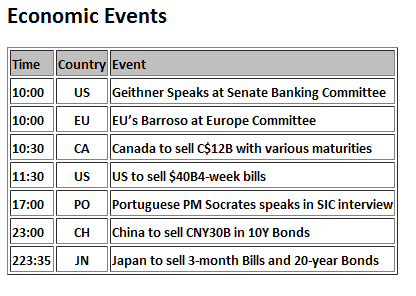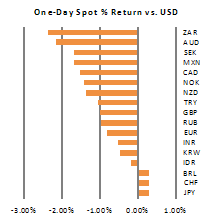Risk Aversion Prompts Safe Haven Flows
BBH CurrencyView
North American Update
- US dollar remains firm across on the board as risk-off dominates
- FOMC meeting unlikely to surprise and Empire manufacturing should remain firm, while German Zew confidence dropped to 14.1, below expectations
- Growth-sensitive currencies are leading the loss in the G10 versus the dollar
The US dollar extended its gains against most major currencies but continues to trade with a weaker tone against the yen and the Swiss franc. Price action is being driven by a new bout of risk aversion following explosions to Japanese power plants. The euro and sterling are lower as the draw of the safe haven dollar outshines European currencies. The euro has settled back under $1.390, while sterling made a new of $1.597. The dollar, however, fell below ¥81.50 against the yen on continued repatriation flows while USD/CHF is hovering around the 0.92 level driven by risk aversion. Global equity markets have been hard hit with the Nikkei down nearly 9%, after falling as much as 12% intraday as markets dumped riskier assets and push funds into safe havens. European indices are lower between 2.0% and 4.5% and US equity futures are pointing to a 2.5% lower open. Increased risk of a global slowdown led to a fall of nearly 2% in oil prices and global sovereign debt yields are sharply lower, declining between 7 and 12bps across major European and US Treasury curves. European periphery yields continue to decline on positive sentiment following last weekend’s expanded agreement on the bailout packages.
The dollar has been falling since the middle of February as the outlook for monetary policies have diverged. The Fed is clearly remaining on the sidelines, while other major central’s banks have indicted their intent to hike. This divergence has led to a widening of interest rate differentials and in turn has prompted the outperformance of currencies with rising yields. At the same time, US data has underperformed expectations and in part has led to expectations of a Fed rate hike to come later, with Fed fund futures not implying a hike until the middle of 2012. Going forward, the market will remain focused on the Fed’s language for any indications of a shift sentiment. Nevertheless, the FOMC statement is unlikely to be changed much from the January and therefore is unlikely to spur much a market reaction. We expect that the Fed statement will largely adhere to the same script as the first paragraph offers and economic assessment. While the precise wording may be tweaked, the Fed’s assessment that the pace of the recovery is insufficient to “bring about significant improvement in the labor market conditions remains valid (though we expect the Fed to acknowledge the general improvement in the macro data). The Fed is also expected to retain its “extended period” language and reiterate that it is maintaining its $600bln in QE2 policy, in our view. On inflation, the Fed is likely to say that core inflation remains low and to the extent that inflation expectations have risen appears to reflect more near-term, transitory expectations in the face of higher oil prices, rather than a permanent shift in longer-term expectations. On balance, the Fed’s meeting is likely to be a non-event with the attention focused on the April 27th meeting for any indication that the Fed is shifting is language on QE2.
The growth sensitive currencies in the G10 are leading the selloff against the dollar as the crisis in Japan intensifies. Overall, the AUD, SEK and CAD are all sustaining heavy losses versus the greenback, with the AUD reaching a new six-week low. The SEK is at its weakest level against the dollar since late February, while the CAD is likely to test similar levels with the dollar’s recent high of $0.995 beckoning. In the face of the escalating crisis, market positioning is critical and with the recent CFTC futures positioning indicating a continued increase in net long holdings of growth-sensitive currencies we feel that these currencies are the most sensitive in the recent bout of risk aversion. As such, it is very likely that short-term positioning unwinds remains a key driver for these currencies, with the Australian dollar the most susceptible to geographic concerns, with the selling pressure exacerbated by the soft RBA minutes. CAD and SEK, meanwhile, remain strongly correlated to changing risk appetite and are likely to remain under pressures as stocks slide.



A firm dollar will harm any domestic recovery and reduce much needed exports. This could mean that QE will have to be increased to reduce the dollar inflating yet more bubbles in Asia and Latin America. I cannot see this being good for anyone.
A firm dollar will harm any domestic recovery and reduce much needed exports. This could mean that QE will have to be increased to reduce the dollar inflating yet more bubbles in Asia and Latin America. I cannot see this being good for anyone.